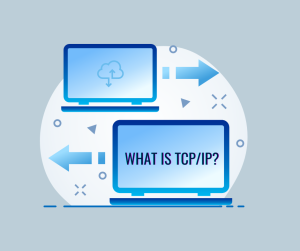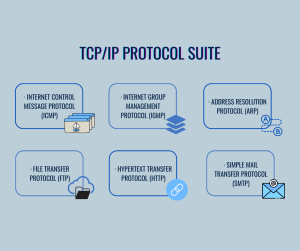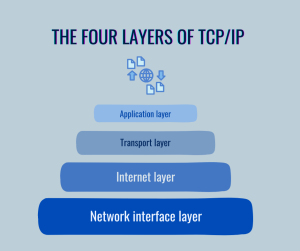In just a few decades, computers have gone from having few functions and filling up entire rooms to becoming portable necessities for business and leisure. However, on its own and not connected to the internet, an electronic device can only do so much.
Most things we rely on technology for require communication between multiple devices—which is where internet protocols come into play.
What does TCP/IP stand for and how is it used in practice?
From sending a simple message to streaming a film or answering transferred calls online, internet use has become so commonplace that we rarely give our actions a second thought. But for all this online activity to be possible, there’s a lot taking place behind the scenes. Let’s start by talking about TCP/IP—the framework most commonly used to transmit data over the internet and other networks.
TCP/IP stands for Transmission Control Protocol/Internet Protocol. The job of TCP/IP is to ensure all communication traveling through the network reaches the intended recipient. It does this by breaking data down into smaller units (packets), which are then reconstituted upon reaching their final destination.
Is there a difference between TCP and IP?
Originally designed by scientists Vint Cerf and Bob Kahn in the 1970s, the Transmission Control Protocol suite has since become the standard method to transfer information. As the name suggests, there are two parts to the picture, and both are equally as important.
The latter part of the TCP/IP abbreviation stands for Internet Protocol. The Transmission Control Protocol and Internet Protocol each take care of a different issue to reach a common goal—the successful transmission of data across a network.
IP operates within what’s known as the network layer, while TCP works within the transport layer. In other words, IP locates the address for delivering data, and TCP takes care of transferring it, as well as correcting errors along the way to ensure successful end-to-end delivery.
To give a real-life example, imagine you’re planning a mass email marketing campaign. You’ve collated a list of email addresses (similar to the IP addresses used by the Internet Protocol to locate intended destinations). By delivering your messages to the recipient, the software through which you send the emails functions much like Transmission Control Protocol.
Lacking either email addresses or suitable software would impede information transfer; similarly, TCP and IP have to work together to be effective.

What constitutes the TCP/IP protocol suite?
We’ve now established why TCP/IP can’t function without one another, but the closer you look, the more complex the protocol suite gets. It consists of many supporting models that are fundamental to its function, such as:
- Internet Control Message Protocol (ICMP)
Whenever a problem materializes during data transmission, it’s the ICMP’s role to send out error messages and operational information. - Internet Group Management Protocol (IGMP)
IGMP allows for multicasting i.e sending out the same data to multiple devices at the same time. - Address Resolution Protocol (ARP)
As a communication protocol, ARP helps connect the internet layer address to the link-layer address. - File Transfer Protocol (FTP)
FTP allows for transferring files from a client to a server. For instance, this protocol is what enables us to access data stored in the cloud—look up ‘what is an iPaaS’ to find out more. - Hypertext Transfer Protocol (HTTP)
Commonly known as HTTPS’ ancestor—only with less data security—HTTP is what makes the interaction between the client and the webserver possible. It’s often considered the foundation for data communication. - Simple Mail Transfer Protocol (SMTP)
SMTPs allow computers and servers to exchange data so users are able to send and receive electronic mail.

What are the four layers of TCP/IP?
TCP/IP is comprised of the following four layers, each of which has a unique set of properties and functions that contribute to the optimal function of the TCP/IP system.
Network interface layer
Also called the ‘network access layer’, this part of the TCP/IP model is where a connection between a physical network and a device is formed. The network interface layer defines how data should be sent and received over the network.
In physical devices, such as routers, the network interface layer plays an extremely important role in connecting the device to other users of the network who can then transmit data packets.
In everyday use, laptops and smartphones rely on the network interface layer to connect to wireless networks and access necessary functions such as online messaging or entertainment apps.
Internet layer
The second layer, also known as the ‘network layer’, combines various protocols (such as IP, ICMP, or ARP) to effectively transfer data sequences across the internet.
In the internet layer, each device is identified through a unique IP, which allows the packets to be sent to the correct address.
For instance, when sending an email, the message is cut up into packets to be rebuilt into its original coherent form in the recipient’s inbox.
Transport layer
The transport layer maintains control over the amount of data to be sent and where it’s sent to. To eliminate errors in inter-system communication, the transport layer engages in flow control, error correction, sequencing, segmentation, and de-segmentation.
When data gets lost in transmission, the expert troubleshooter that is the transport layer requests the packet be rerouted and received correctly. It also takes care of the efficient flow of information throughout the network by breaking up data into manageable segments.
It’s important to note that all information sharing comes with safety risks—if you’re concerned about privacy, spam call blocking software could be worth looking into.
Application layer
Within the topmost application layer, the user gets to interact with other software applications ranging from file sharing to remote desktop services.

Conclusion
The world of data transfer is extremely complex, with many factors combining to ensure that information leaves and arrives in the right shape and form to the correct recipient.
Internet protocol suites, of which TCP/IP is the most commonly used, are what make online communication possible. This is comprised of four layers and relies on a variety of supporting models to transfer data across the network in a reliable and efficient manner.
Pandora FMS’s editorial team is made up of a group of writers and IT professionals with one thing in common: their passion for computer system monitoring. Pandora FMS’s editorial team is made up of a group of writers and IT professionals with one thing in common: their passion for computer system monitoring.

















